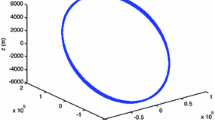Abstract
This paper is devoted to the study on applying numerical techniques to accurately compute and robustly extend the libration point orbits (LPOs). A new methodology is proposed exploiting the hyperbolic dynamics of the collinear libration points. Numerical tools are developed to facilitate the efficient computation process, which are applicable to realistic force models and inherently parallelizable. Extensive numerical explorations in the Earth–Moon system are carried out, revealing the delicate structures of nested island chains and bounded chaotic motions on the center manifold. Numerical results confirm that the proposed approach can handle the computations of various types of LPOs in a unified manner and is operational over a wide range of energy levels. LPOs obtained with this approach offer a broad range of future mission possibilities in an extended vicinity of the collinear libration points.






























Similar content being viewed by others
References
Astakhov, S.A., Burbanks, A.D., Wiggins, S., Farrelly, D.: Chaos-assisted capture of irregular moons. Nature 423(6937), 264–267 (2003)
Barden, B.T., Howell, K.C.: Formation flying in the vicinity of libration point orbits. Adv. Astronaut. Sci. 99(z), 969–988 (1998)
Barden, B.T., Howell, K.C.: Dynamical Issues Associated with Relative Configurations of Multiple Spacecraft Near the Sun-Earth/Moon L1 Point. In AAS/AIAA Astrodynamics Specialists Conference, Paper No. AAS99-450, 2307–2325 (1999)
Breakwell, J.V., Brown, J.V.: The Halo family of three dimensional periodic orbits in the earth-moon restricted three body problem. Celest. Mech. 20(4), 389–404 (1979)
Brent, R.P.: Algorithms for Minimization without Derivatives, Chapter 4. Prentice-Hall, Englewood Cliffs, NJ (1973)
Doedel, E.J., Romanov, V.A., Paffenroth, R.C., Keller, H.B., Dichmann, D.J., Gal’an-Vioque, J., Vanderbauwhede, A.: Elemental periodic orbits associated with the libration points in the circular restricted 3-body problem. Int. J. Bifurcat. Chaos 17(08), 2625–2677 (2007)
Farquhar, R.W.: Lunar communications with libration-point satellites. J. Spacecr. Rockets 4(10), 1383–1384 (1967)
Farquhar, R.W., Kamel, A.A.: Quasi-periodic orbits about the translunar libration point. Celest. Mech. 7(4), 458–473 (1973)
Gómez, G., Mondelo, J.M.: The dynamics around the collinear equilibrium points of the RTBP. Physica D 157(4), 283–321 (2001)
Gómez, G., Masdemont, J.J., Simó, C.: Quasihalo orbits associated with libration points. J. Astronaut. Sci. 46(2), 135–176 (1998)
Gómez, G., Jorba, À., Masdemont, J., Simó, C.: Dynamics and Mission Design Near Libration Point Orbits, Vol. 3: Advanced Methods for Collinear Points. World Scientific, Singapore (2000)
Gómez, G., Jorba, A., Simó, C., Masdemont, J.J.: Dynamics and Mission Design Near Libration Points–Volume III: Advanced Method for Collinear Points, vol. 4. World Scientific, Singapore (2001a)
Gómez, G., Llibre, J., Matinez, R., Simó, C.: Dynamics and Mission Design Near Libration Point Orbits — Volume I: Fundamentals: The Case of Collinear Libration Points, vol. 2. World Scientific, Singapore (2001b)
Gómez, G., Koon, W.S., Lo, M.W., et al.: Connecting orbits and invariant manifolds in the spatial restricted three-body problem. Nonlinearity 17(5), 1571 (2004)
Hechler, M., Cobos, J., d’Aiguablava, P.: Herschel, Planck and Gaia orbit design. In: International Conference on Library Point Orbits and Applications, 115–135. Girona, Spain (2002)
Hénon, M.: Vertical stability of periodic orbits in the restricted problem. I. Equal masses. Astron. Astrophys. 28, 415 (1973)
Hénon, M.: Generating Families in the Restricted Three-Body Problem. Lecture Notes in Physics Monographs, M52. Springer (1997)
Hénon, M.: Generating Families in the Restricted Three-Body Problem. II Quantitative Study of Bifurcations. Lecture Notes in Physics Monographs, M65. Springer (2001)
Howell, K.C.: Three-dimensional, periodic, Halo orbits. Celest. Mech. 32(1), 53–71 (1984)
Howell, K.C., Pernicka, H.J.: Numerical determination of Lissajous trajectories in the restricted three-body problem. Celest. Mech. 41(1–4), 107–124 (1987)
Howell, K.C., Marchand, B.G., Lo, M.W.: Temporary satellite capture of short-period Jupiter family comets from the perspective of dynamical systems. J. Astronaut. Sci. 49(4), 539–557 (2001)
Jorba, A., Masdemont, J.J.: Dynamics in the center manifold of the restricted three-body problem. Physica D 132, 189–213 (1999)
Jorba, A., Villanueva, J.: Numerical computation of normal forms around some periodic orbits of the restricted three-body problem. Physica D 114(3), 197–229 (1998)
Kolemen, E., Kasdin, N.J., Gurfil, P.: Multiple Poincar’e sections method for finding the quasiperiodic orbits of the restricted three body problem. Celest. Mech. Dyn. Astron. 112(1), 47–74 (2012)
Koon, W.S., Lo, M.W., Marsden, J.E., Ross, S.D.: Heteroclinc connections between periodic orbits and resonance transitions in celestial mechanics. Chaos 10, 427–469 (2001)
Koon, W.S., et al.: Dynamical systems, the three-body problem and space mission design. 9 (2008). Accessed 21
Nacozy, P.E.: The use of integrals in numerical integrations of the N-body problem. Astrophys. Space Sci. 14(1), 40–51 (1971)
Press, W.H., Flannery, B.P., Teukolsky, S.A., et al.: Numerical recipes: the art of scientific computing. Cambridge University Press, New York (1986)
Ren, Y., Shan, J.: A novel algorithm for generating libration point orbits about the collinear points. Celest. Mech. Dyn. Astron. 120(1), 57–75 (2014)
Richardson, D.L.: Analytic construction of periodic orbits about the collinear points. Celest. Mech. 22(3), 241–253 (1980a)
Richardson, D.L.: Halo orbit formulation for the ISEE-3 mission. J. Guid. Control. Dyn. 3(6), 543–548 (1980b)
Stiefel, E.L., Scheifele, G.: Linear and regular celestial mechanics. Perturbed two-body motion. Numerical methods. Canonical theory. Translated from the English edition. Moskva: Nauka, 303 (1975)
Szebehely, V.: Theory of Orbits: The Restricted Problem of Three Bodies. Academic Press, New York (1967)
Szebehely, V., Bettis, D.G.: Recent developments of integrating the gravitational problem of N-bodies. Astrophys. Space Sci. 13(2), 365–376 (1971)
Villac, B.F., Scheeres, D.J.: A simple algorithm to compute hyperbolic invariant manifolds near L1 and L2. AAS/AIAA Spaceflight Mechanics Meeting, Maui, Hawaii, Paper AAS (2004)
Acknowledgments
This work was supported by the National Natural Science Foundation of China (Grant No. 11403013), the Fundamental Research Funds for the Central Universities (No. 56XAA14093, 56YAH12036) and Postdoctoral Foundation of Jiangsu Province (No. 1301029B).
Author information
Authors and Affiliations
Corresponding author
Rights and permissions
About this article
Cite this article
Zhang, H., Li, S. A general method for the generation and extension of collinear libration point orbits. Celest Mech Dyn Astr 126, 339–367 (2016). https://doi.org/10.1007/s10569-016-9698-8
Received:
Revised:
Accepted:
Published:
Issue Date:
DOI: https://doi.org/10.1007/s10569-016-9698-8




